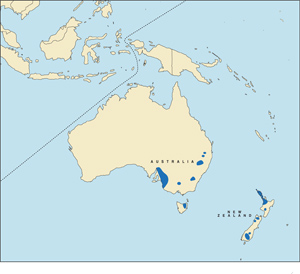European Fallow Deer - South Pacific | Online Record Book Preview
This is a preview of the European Fallow Deer - South Pacific species only.
Once you subscribe you will be able to view all the entry details for hundreds of different species, including full score sheets and photos.
This species has several classifications, to view each one you can click on the links below to jump down to that section:
European Fallow Deer - South Pacific |
 |
Dama dama
Gamo (Sp), Damhirsch (G), Daim (F). "Fallow" is from the Old English fealu, a light yellowish-brown color.
DESCRIPTION (male) Shoulder height 36-38 inches (91-97 cm), weight 150-200 pounds (68-91 kg) and occasionally more. The female is smaller than the male.
A medium-sized deer that has more color variations than any other deer. The four principal ones in European deer parks are reddish-brown with white spots, menil, white, and blackish-brown, and there also are many intermediate color types. All have white rumps and light-colored underparts. All except the white fallow have a dark dorsal stripe. According to Allison, fallow deer in South Australia are mostly of the spotted reddish-brown type; those in New South Wales are mainly blackish-brown, but there also are some spotted reddish-brown animals; Tasmania has all colors; and most New Zealand specimens are of the dark variety. Fallow deer antlers have brow and trez tines, with the bez tines normally absent, and they have well-palmated tops with a number of tines coming off the rear of the palmation.
BEHAVIOR Social behavior varies: gregarious in some areas, with herds sometimes as large as 80 or more, but may be more or less solitary elsewhere. Herds are usually led by females. Males establish small territories during the rut (March-April in Australia and Tasmania, mid-April to mid-May in New Zealand) and fight each other, roaring and grunting, while gathering harems. Often they are severely injured or even killed in such fights, though they are shy, gentle animals at other times.
Fallow deer are diurnal and essentially grazers, but they also browse on shrubs and trees and are very fond of crops. Eyesight and sense of smell are good, hearing is excellent. Extremely agile.
HABITAT Mainly open lowland woodlands. According to Allison, "wherever you find fallow deer in Australia, there are always four common factors: permanent water, crops or improved pasture, large stands of wattles, and nearby dense scrub."
DISTRIBUTION Australia: Tasmania has the largest population of wild fallow deer, followed by New South Wales and southeastern South Australia. In addition there are a few in western Victoria and extreme southeastern Queensland. Enclosed fallow are found on a number of private properties. New Zealand: Wild fallow are found on both North and South Islands, where they live in 13 populations scattered from north of Auckland to Southland. Enclosed fallow are found on many private properties.
REMARKS First introduced in Tasmania in either 1829 or 1834, and from there imported to the mainland of Australia in 1862. First introduced on New Zealand's South Island in 1864 and on North Island in 1877. There were a great many subsequent introductions in both countries in the years to follow. Most deer were imported from English game parks, with the stock said to be a blend of animals from Denmark, Sweden and Greece. The fallow deer is the most widespread deer in Australia and the second most widespread in New Zealand.
|
Classifications
European Fallow Deer (free range) - Species Detail |
| Scientific Name: |
Dama dama |
Gold: |
210 7/8" |
Gold (Bow): |
148" |
| AKA: |
|
Silver: |
188 5/8" |
Silver (Bow): |
0" |
| Endangered: |
|
Bronze: |
150" |
Bronze (Bow): |
135" |
| Member |
Taken |
Location |
Hunting Company/Guide |
Measurer |
MOK |
Score |
OR |
MR |
The European Fallow Deer (free range) currently has 290 Entries listed in the SCI Record Book!
Once you subscribe you'll be able to access photos and full socre sheets for all of these entries. Plus you can filter, sort, and search through all species and entries in the SCI database. If you would like to subscribe now to have access to the entire database, please click here.
|
Return to Top
European Fallow Deer - Species Detail |
| Scientific Name: |
Dama dama |
Gold: |
231 6/8" |
Gold (Bow): |
213 6/8" |
| AKA: |
|
Silver: |
203 3/8" |
Silver (Bow): |
201 1/8" |
| Endangered: |
|
Bronze: |
153" |
Bronze (Bow): |
138" |
| Member |
Taken |
Location |
Hunting Company/Guide |
Measurer |
MOK |
Score |
OR |
MR |
The European Fallow Deer currently has 512 Entries listed in the SCI Record Book!
Once you subscribe you'll be able to access photos and full socre sheets for all of these entries. Plus you can filter, sort, and search through all species and entries in the SCI database. If you would like to subscribe now to have access to the entire database, please click here.
|
Return to Top
|




